Suffolk England
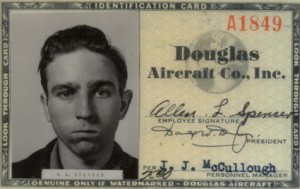 My dad, Allen Spencer, went to work for Douglas Aircraft Company on May 19, 1942. He was a young man of just 18 years. Dad wasn’t with Douglas Aircraft Company for very long, because of World War II, and his enlistment in the Army Air Force on March 12, 1943. Nevertheless, the job my dad had while he was at Douglas Aircraft Company would play a big part in his future military assignment as a flight engineer on a B-17 Bomber during World War II, stationed at RAF Great Ashfield in Suffolk, England. Because of Dad’s job there, I have always had an interest in Douglas Aircraft Company.
My dad, Allen Spencer, went to work for Douglas Aircraft Company on May 19, 1942. He was a young man of just 18 years. Dad wasn’t with Douglas Aircraft Company for very long, because of World War II, and his enlistment in the Army Air Force on March 12, 1943. Nevertheless, the job my dad had while he was at Douglas Aircraft Company would play a big part in his future military assignment as a flight engineer on a B-17 Bomber during World War II, stationed at RAF Great Ashfield in Suffolk, England. Because of Dad’s job there, I have always had an interest in Douglas Aircraft Company.
While people might think they don’t know much about Douglas Aircraft Company, they really do, just under a different name. The Douglas Aircraft Company was an American aerospace manufacturer based in Southern California. It was founded in 1921 by Donald Wills Douglas Sr and later merged with McDonnell Aircraft in 1967 to form McDonnell Douglas. With that merger, Douglas Aircraft Company ceased to exist. The name McDonnell Douglas might be a bit more familiar to people, but it was really when McDonnell Douglas merged with Boeing in 1997 that the company became a household name. Everyone has heard of Boeing Aircraft Company.
While Douglas Aircraft Company no longer exists, they made great strides in the aerospace industry during their time in business. One early claim to fame was the first circumnavigation of the world by air in Douglas airplanes in 1924. That was just 21 years after the first powered flight, taken by the Wright Brothers. That may sound like a long time, but to go from the rickety-looking plane the Wright Brothers flew, to something that was  capable of making the flight around the world in just 21 years is truly outstanding. The circumnavigation mission was first presented to Douglas Aircraft Company in 1923, when the US Army Air Service, interested in carrying out a mission to circumnavigate the Earth for the first time by aircraft, approached Douglas Aircraft Company to present it to them. The mission was called “World Flight.” Donald Douglas proposed a modified Douglas DT to meet the Army’s needs. The two-place, open cockpit DT biplane torpedo bomber had previously been produced for the US Navy. The DTs were taken from the assembly lines at the company’s manufacturing plants in Rock Island, Illinois, and Dayton, Ohio, to be modified.
capable of making the flight around the world in just 21 years is truly outstanding. The circumnavigation mission was first presented to Douglas Aircraft Company in 1923, when the US Army Air Service, interested in carrying out a mission to circumnavigate the Earth for the first time by aircraft, approached Douglas Aircraft Company to present it to them. The mission was called “World Flight.” Donald Douglas proposed a modified Douglas DT to meet the Army’s needs. The two-place, open cockpit DT biplane torpedo bomber had previously been produced for the US Navy. The DTs were taken from the assembly lines at the company’s manufacturing plants in Rock Island, Illinois, and Dayton, Ohio, to be modified.
Four of these modified aircraft left Seattle, Washington, on April 6, 1924, flying west, and two of these returned there on September 28 to great fanfare. Unfortunately, one plane had been lost under fog conditions, and another was forced down over the Atlantic and sank. The DWC prototype was then rechristened and joined the other two in completing the North American leg of the flight. With the success of this flight, the Army Air Service ordered six similar aircraft as observation aircraft.
In 1934, Douglas produced a commercial twin-engined transport plane, the Douglas DC-2, which was followed by the famous DC-3 in 1936. The wide range of aircraft produced by Douglas included airliners, light and medium bombers, fighter aircraft, transports, reconnaissance aircraft, and experimental aircraft. While these were all important types of aircraft, it would really be the work they did during World War II, that really put 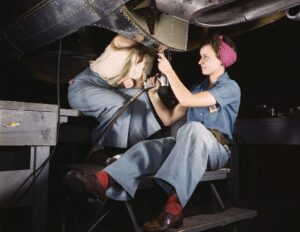 them on the map in my opinion. With so many young men heading off to war, the women really stepped up at this time and built many of the World War II planes. During that time, Douglas joined the BVD (Boeing-Vega-Douglas) consortium to produce the B-17 Flying Fortress. As far as I’m concerned, that was one of the greatest planes every produced. I suppose that sounds odd, considering that it was so long ago, but for its time, the B-17 was and really still is legendary. And while I don’t know if my dad had a part in building the B-17 Bomber, I know that he repaired them and knew them inside and out. I am proud of the work my dad did on the airplanes he helped to build, and proud of his time with Douglas Aircraft Company.
them on the map in my opinion. With so many young men heading off to war, the women really stepped up at this time and built many of the World War II planes. During that time, Douglas joined the BVD (Boeing-Vega-Douglas) consortium to produce the B-17 Flying Fortress. As far as I’m concerned, that was one of the greatest planes every produced. I suppose that sounds odd, considering that it was so long ago, but for its time, the B-17 was and really still is legendary. And while I don’t know if my dad had a part in building the B-17 Bomber, I know that he repaired them and knew them inside and out. I am proud of the work my dad did on the airplanes he helped to build, and proud of his time with Douglas Aircraft Company.
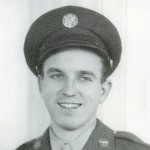 I have been reading some of my dad’s letters that were written to his family while he was in the Army Air Force during World War II. They were written from places as familiar to me as Salt Lake City and as unfamiliar as Great Ashfield, Suffolk, England. He told of all the new experiences he was having, such as flying in the B-17 Bomber, and just checking out the area where he was stationed. And he told of attending church services quite often…something that didn’t change throughout his entire life, and for that I’m thankful. That one thing brings me so much peace of mind…knowing that I will see my dad again.
I have been reading some of my dad’s letters that were written to his family while he was in the Army Air Force during World War II. They were written from places as familiar to me as Salt Lake City and as unfamiliar as Great Ashfield, Suffolk, England. He told of all the new experiences he was having, such as flying in the B-17 Bomber, and just checking out the area where he was stationed. And he told of attending church services quite often…something that didn’t change throughout his entire life, and for that I’m thankful. That one thing brings me so much peace of mind…knowing that I will see my dad again.
But, as I read his letters, there was some sadness in his tone. The life he knew was changing every day, and he was too far away, and powerless to stop it. He was always concerned about his mother and sister living so far out of town on the farm, and even asked his brother to rent them a house in town so life would be easier on them, but then when it seemed that they would not be going back to the farm, it was hard to think of coming home to an unfamiliar house. Then, his brother was thinking about getting married (which he didn’t do at that time or to that girl), and moving to Mexico to work for a time, and it looks like he would not be there for his only brother’s wedding. Suddenly it occurs to my dad that so often, life changes when you least expect it, and you find yourself not ready for those changes. I suppose this is a common feeling with military personnel, in that they have little say about where they are stationed, how long they are there, and when they might get leave.
Life changes are hard anyway, and I suppose that being thousands of miles from home would make them seem so much more unbelievable and unsettling. For me, knowing that my mom still lives in the home I grew up in gives a strong sense of stability, but knowing that my dad is no longer here, is very unsettling. In his letters, dad wondered about men he knew from back home, and asked about their whereabouts often. He was praying for their safety, as I am sure they were for his. I have wondered about those men too. So far, in my reading, he has received no answers about those men, so I wonder if he ever heard news of them. I may never find out.
I don’t like change much myself…at least not the kind that brings with it the sadness of loss. Whether it is loss of childhood days, or loss of life, all loss is painful. I know that the service our military men do for their country and its citizens is necessary, and those who serve are honorable men who deserve our deepest thanks, but I have to mourn with them the loss of parts of their lives that must be sacrificed so others can have the freedoms we so enjoy.
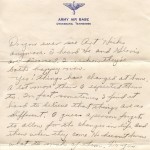 As for my dad, I know that the life he returned to after the war was vastly different than the one he left behind, and I feel a deep sorrow for him in that he must have felt that loss deeply. Dad never talked much about the war, and in fact any information we got had to be pried out of him. Maybe some memories are too painful to relive, and are best left alone. Still, Dad’s letters have shown me a side of my dad that I didn’t exactly know existed…or maybe I did. Dad was always a very caring man, who was extremely loyal to his family…be it his mother, dad, sisters and brother, or my mom, my sisters and me. I suppose that all of life’s changes mold us into the people we are, and so they must be.
As for my dad, I know that the life he returned to after the war was vastly different than the one he left behind, and I feel a deep sorrow for him in that he must have felt that loss deeply. Dad never talked much about the war, and in fact any information we got had to be pried out of him. Maybe some memories are too painful to relive, and are best left alone. Still, Dad’s letters have shown me a side of my dad that I didn’t exactly know existed…or maybe I did. Dad was always a very caring man, who was extremely loyal to his family…be it his mother, dad, sisters and brother, or my mom, my sisters and me. I suppose that all of life’s changes mold us into the people we are, and so they must be.
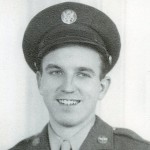 Today is Veteran’s Day, and most of us have a Veteran we think of when we think of this day. They are the heroes who served their country, protecting our nation and other nations around the world. They willingly answer the call when the enemy rears its ugly head and we have to go in and push them back, so the freedoms that we so love can continue to exist for us and for other nations. My dad was one of those heroes.
Today is Veteran’s Day, and most of us have a Veteran we think of when we think of this day. They are the heroes who served their country, protecting our nation and other nations around the world. They willingly answer the call when the enemy rears its ugly head and we have to go in and push them back, so the freedoms that we so love can continue to exist for us and for other nations. My dad was one of those heroes.
Dad joined the Army Air Forces on March 19, 1943 at the age of 18. He would turn 19 on April 27, 1943. He had been employed at Douglas Aircraft Company Inc since May 19, 1942, so I’m sure the Army Air Forces could see that he had experience in the mechanics of airplanes. Dad deployed with his crew in a brand new B-17G Bomber to Great Ashfield, Suffolk, England in April of 1944. Dad was trained as the flight engineer. That is a position of great importance on a plane, in that he knew everything about the plane, and if anything went wrong, he was the one who had to fix it. If he couldn’t fix it, they would likely crash, so he needed to know everything about the plane, and Dad did. Once when the landing gear would not come down, Dad had to hang upside down in the open bomb bay, while his crew held on to him, and hand crank the landing gear until it was down and locked. I’m quite sure there were many sighs of relief when the gear was finally down. Dad was also the top turret gunner on the B-17G Bomber, and received the Distinguished Flying Cross, the Air Medal with four Oak Leaf Clusters, signifying that he had shot down four German planes, and two Gold Stars, signifying that he had taken part in two major aerial engagements. In all he would take part in 35 bombing missions before he was honorably discharged on October 3, 1945.
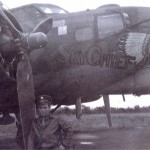
During the time Dad was in the service, he sent most of his pay home in the form of war bonds, telling his mother that if she needed the money, she was to use any or all of it. He wrote letters to her as often as he could…his way of letting her know he was ok. He worried more about his mom worrying about him than he did about himself. He was a hero to his mom, as well as to his country. And he carried that heroic attitude through the rest of his life…always putting the needs of those he loved and even those he didn’t know ahead of his own. That is what makes a true hero. That is what my dad was. I am so proud of you Dad. I love and miss you very much.
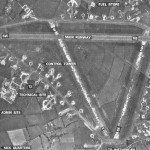
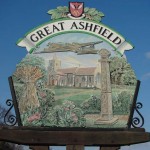 We look back on the wars of the past and where we fought them, and no matter how hard we try to cover up those places…to erase the past as it were, the earth remembers. My dad was stationed at Great Ashfield in Suffolk, England during World War II. That was a very busy place in those days, and the people who lived there during the war were grateful to the men of the 8th Air Force. Great Ashfield was largely a B-17 base, and the towns around the base were fairly safe, because the 8th Air Force was very capable and much feared. Their very presence made people feel safer, in a time when feeling safe was…well, a precious commodity.
We look back on the wars of the past and where we fought them, and no matter how hard we try to cover up those places…to erase the past as it were, the earth remembers. My dad was stationed at Great Ashfield in Suffolk, England during World War II. That was a very busy place in those days, and the people who lived there during the war were grateful to the men of the 8th Air Force. Great Ashfield was largely a B-17 base, and the towns around the base were fairly safe, because the 8th Air Force was very capable and much feared. Their very presence made people feel safer, in a time when feeling safe was…well, a precious commodity.
The area where the air base was at that time is still marked by the memorials to the men who kept them safe during that awful time. A beautiful sign decorated with a B-17 Bomber still marks the Great Ashfield Gate. It is a tribute to those great men who fought and died to protect the lives of people they didn’t even know. Fighting for people they don’t even know is after all the core of every person in the military. It is maybe something we civilians don’t really understand…until someone steps up and does it for us. That is how those people felt, and why they continue to honor those great men to this day…the earth remembers.
I looked Great Ashfield up on Google Earth. We are blessed today to have the ability to take a virtual tour of places we might never have seen otherwise. When I first looked it up, while I was making a book of my dad’s war days for my dad and my Uncle Bill, all you could see was from the air, and while the air base is no longer an air base, you can still see exactly where it was, and a small part of it is still used for small planes today…the earth remembers.
Tonight as I write this I looked it up again, and now you can actually get right down to the edge of the base, as if you were standing right there. Google Earth now takes those street views, and Great Ashfield is one of them they have done. As I looked at the edge of the base, tears came up in my eyes, and I got a lump in my throat, because I knew that this was a place where my dad had walked…his old stomping grounds, as the old saying goes. 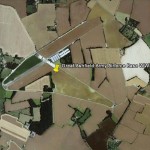
 Dad had told me about three Poplar trees at the end of the runway, and all the men knew that when you saw those three Poplar trees, you were safe. The enemy wouldn’t dare follow you here. As I stood there at the edge of the base, looking around the area, I was almost dumbfounded when those same three Poplar trees came into view…just like in the pictures I had found. They are still there to this day, as a reminder, at least to me that my dad always made it safely home…the earth remembers, and so do I.
Dad had told me about three Poplar trees at the end of the runway, and all the men knew that when you saw those three Poplar trees, you were safe. The enemy wouldn’t dare follow you here. As I stood there at the edge of the base, looking around the area, I was almost dumbfounded when those same three Poplar trees came into view…just like in the pictures I had found. They are still there to this day, as a reminder, at least to me that my dad always made it safely home…the earth remembers, and so do I.

